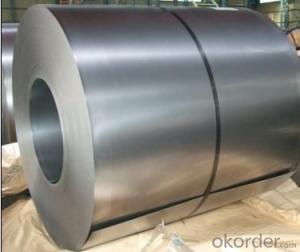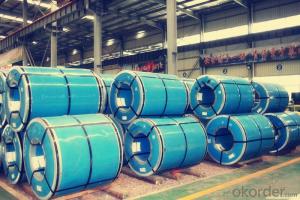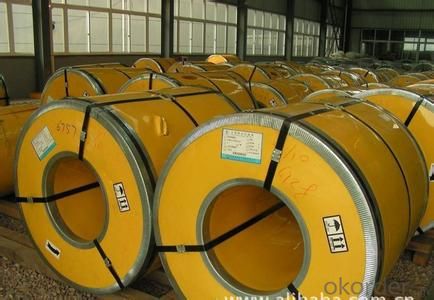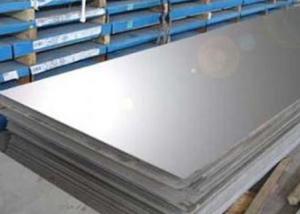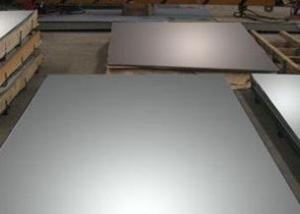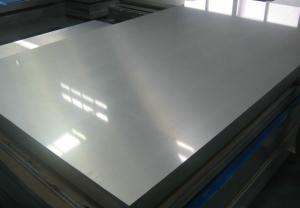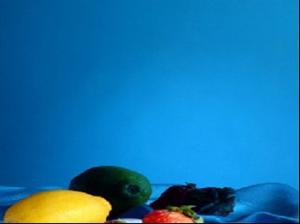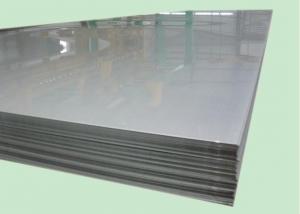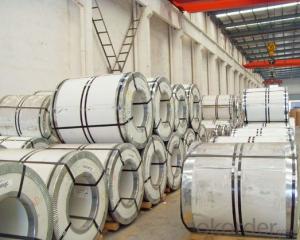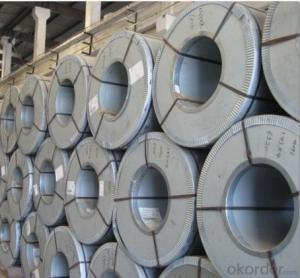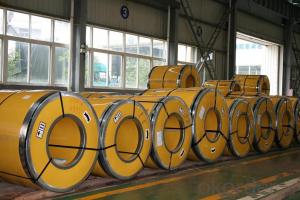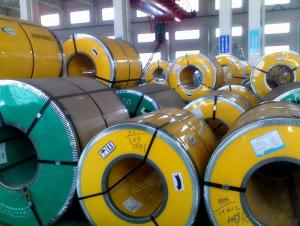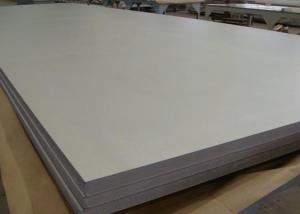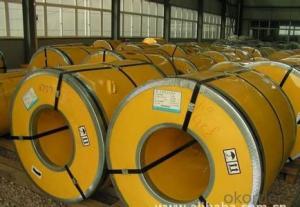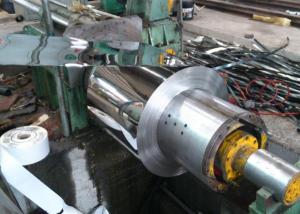Stainless Steel Coil/Sheet/Strip 304 Cold Rolled 2B/NO.1
- Loading Port:
- Ningbo
- Payment Terms:
- TT OR LC
- Min Order Qty:
- 100 m.t.
- Supply Capability:
- 20000 m.t./month
OKorder Service Pledge
OKorder Financial Service
You Might Also Like
Chemical composition: | |||||||
C | Si | Mn | Cr | Ni | S | P | |
≤0.07 | ≤1.0 | ≤2.0 | 18.0~20.0 | 8.0~11.0 | ≤0.03 | ≤0.035 | |
mechanical properties: | |||||||
Tensile strength σb (MPa) | Conditions yield strength 0.2 sigma (MPa) | Elongation δ5 (%) | Section shrinkage (%) | Hardness | |||
520 | 205 | 40 | 60 | ≤1 | |||
Hot Rolled Stainless Steel Coil 304 Annealing and Pickling No.1 Finish
Stainless steel is a production which not easy rust,acid resistance and corrosion resistance,so it is widely
used in light industry,heavy industry,daily necessities and the decoration industry.
Hot Rolled Stainless Steel Coil 304 Specifications
1.surface:NO.1
2.standard:JIS, AISI, GB
3.width: 0.55m, 0.65m, 1.0m, 1.22m, 1.5m, 2m or requirement
Hot Rolled Stainless Steel Coil 304 Chemical Composition:
(%):C=0.07, Mn=2.00, P=0.045, S=0.030, Si=0.075, Cr=17.5-19.5, Ni=8.0-10.5, N=0.10
Hot Rolled Stainless Steel Coil 304 Physical Properties
Tensile strength σb (MPa) ≥ 520
the conditions yield strength σ0.2 (MPa) ≥ 205,
elongation δ5 (%) ≥ 40
Reduction of ψ (%) ≥ 50,
hardness: ≤ 187
HB; ≤ 90
HRB; ≤ 200H
- Q: Are stainless steel strips suitable for heat treatment processes?
- Yes, stainless steel strips are suitable for heat treatment processes. Heat treatment is a common process used to modify the physical and mechanical properties of metals, including stainless steel. By subjecting stainless steel strips to controlled heating and cooling cycles, it is possible to alter their hardness, strength, and other properties to meet specific requirements. Heat treatment processes such as annealing, quenching, tempering, and precipitation hardening can be applied to stainless steel strips to improve their machinability, formability, and resistance to corrosion. However, it is important to consider the specific grade and composition of stainless steel being used, as some grades may have limitations on the extent of heat treatment that can be applied. Consulting with a metallurgist or material specialist is recommended to ensure the appropriate heat treatment process is selected for specific stainless steel strips.
- Q: What are the different surface textures available for stainless steel strips?
- Different surface textures are available for stainless steel strips, depending on the desired aesthetic and functional needs. The following are some of the most common finishes: 1. No.1 Finish: This finish is achieved through hot rolling, annealing, and pickling, resulting in a rough and dull appearance. It is often used in industrial applications where appearance is not a primary concern. 2. No.2B Finish: This finish is obtained through cold rolling, annealing, and pickling, resulting in a smoother and more reflective surface compared to No.1 finish. It is commonly chosen for applications that require moderate corrosion resistance and a visually appealing look. 3. No.2D Finish: This finish is achieved through cold rolling, annealing, and pickling, resulting in a smoother but less reflective surface than No.2B finish. It is often used in applications that require a smooth surface but not high reflectivity. 4. No.3 Finish: This finish is achieved by using a 120-150 grit abrasive, resulting in a semi-polished surface. It offers a smoother and more reflective appearance than No.2D finish but is not as highly polished as No.4 finish. 5. No.4 Finish: This finish is achieved by using a 150-180 grit abrasive, creating a brushed or satin appearance. It provides a consistent and uniform brushed look, making it ideal for decorative applications that require an appealing finish. 6. No.6 Finish: This finish is achieved by using a 220-240 grit abrasive, resulting in a fine satin appearance. It offers a smooth and reflective surface and is commonly used in architectural and decorative applications. 7. No.8 Finish: This finish is achieved by using a 320-400 grit abrasive, providing a highly polished and mirror-like appearance. It is frequently chosen for decorative applications that require a high level of reflectivity. These finishes offer unique characteristics and benefits for stainless steel strips, catering to specific application requirements.
- Q: Can stainless steel strips be magnetized?
- Yes, stainless steel strips can be magnetized to some extent. Although stainless steel is not inherently magnetic, it can acquire magnetic properties through various methods such as cold working or by adding certain elements to the alloy. However, the magnetism achieved is relatively weak compared to other magnetic materials like iron or nickel.
- Q: What industries commonly use stainless steel strips?
- Stainless steel strips are widely used in various industries due to their exceptional properties and versatility. One industry that commonly utilizes stainless steel strips is the automotive industry. These strips are used for manufacturing various automotive components such as exhaust systems, trim, and decorative elements due to their corrosion resistance, strength, and aesthetic appeal. Another industry that extensively uses stainless steel strips is the construction industry. These strips are employed in the construction of infrastructure, such as bridges, tunnels, and buildings, as they offer excellent structural integrity, durability, and resistance to environmental factors. Stainless steel strips are also utilized for roofing, siding, and cladding applications. The food processing and packaging industry also rely heavily on stainless steel strips. These strips are preferred for their hygienic properties, as they are easy to clean, resistant to bacterial growth, and non-reactive to food products. Stainless steel strips are used in the production of equipment like conveyors, mixers, and food storage containers. Furthermore, the medical and pharmaceutical industries heavily rely on stainless steel strips for their equipment and instruments. Stainless steel's biocompatibility, corrosion resistance, and ease of sterilization make it ideal for surgical tools, dental instruments, medical implants, and pharmaceutical manufacturing equipment. Other industries that commonly use stainless steel strips include the aerospace industry, where they are used for aircraft components, and the energy industry, where they are utilized in power plants, oil and gas processing, and renewable energy systems. Overall, the diverse range of properties offered by stainless steel strips makes them a popular choice across various industries, providing durability, corrosion resistance, hygiene, and strength, among other benefits.
- Q: Are 111 stainless steel strips suitable for high-temperature furnaces?
- High-temperature furnaces necessitate stainless steel grades with greater heat and corrosion resistance, such as 310, 316, or 330. In contrast, 111 stainless steel is a low alloy ferritic stainless steel that is not intended for high-temperature applications. Utilizing 111 stainless steel strips in high-temperature furnaces could result in material deformity, oxidation, and failure, posing potential safety risks and diminishing furnace performance.
- Q: Can stainless steel strips be used in the electronics manufacturing industry?
- Yes, stainless steel strips can be used in the electronics manufacturing industry. They are commonly used for various applications such as shielding, grounding, and structural components in electronic devices. Stainless steel's corrosion resistance and high strength make it suitable for these purposes.
- Q: Are stainless steel strips suitable for oil and gas applications?
- Indeed, stainless steel strips prove to be apt for oil and gas applications. Thanks to its exceptional corrosion resistance, stainless steel emerges as an ideal choice for deployment in oil and gas settings that frequently encounter corrosive elements. Moreover, stainless steel strips boast remarkable strength and durability, enabling them to endure the rigorous conditions and pressures typically encountered in oil and gas operations. Additionally, they possess commendable heat resistance, ensuring that their mechanical properties remain intact even at extreme temperatures. Such properties render stainless steel strips highly suitable for an extensive array of applications within the oil and gas sector, encompassing pipelines, storage tanks, and offshore platforms.
- Q: What are the common lengths of stainless steel strips?
- The common lengths of stainless steel strips can vary depending on the specific application and industry. However, there are some standard lengths that are commonly available. These lengths typically range from 12 inches (30.48 cm) to 144 inches (365.76 cm) or 12 feet (3.66 meters). Stainless steel strips are often sold in standardized sizes to accommodate various uses, such as construction, manufacturing, or fabrication. These lengths allow for easy handling and transportation while providing flexibility for cutting or shaping as per the requirements of the project or application. It's important to note that custom lengths can also be obtained by requesting special orders from suppliers or metal fabricators. These custom lengths are often utilized when specific dimensions are needed to fit certain machinery, equipment, or architectural designs.
- Q: Are stainless steel strips suitable for chemical tanks?
- Indeed, chemical tanks can indeed be made with stainless steel strips. Stainless steel is a highly favored choice when it comes to selecting materials for chemical tanks, primarily due to its remarkable resistance to corrosion and impressive durability. It possesses the ability to endure and withstand exposure to a broad range of chemicals, including acids, bases, and solvents, without succumbing to corrosion or degradation. Furthermore, stainless steel boasts ease of cleaning and maintenance, making it an optimal and sanitary option for the storage and transportation of chemicals. The exceptional strength and structural integrity of stainless steel strips additionally guarantee that the tanks can endure the pressures and stresses encountered in chemical processing applications. All things considered, stainless steel strips are a dependable and appropriate choice as a material for chemical tanks.
- Q: Can stainless steel strips be used in the production of jewelry findings?
- Yes, stainless steel strips can be used in the production of jewelry findings. Stainless steel is often used in jewelry making due to its durability, corrosion resistance, and affordability. It can be formed into various shapes and sizes, making it suitable for creating findings such as clasps, jump rings, earring hooks, and more.
Send your message to us
Stainless Steel Coil/Sheet/Strip 304 Cold Rolled 2B/NO.1
- Loading Port:
- Ningbo
- Payment Terms:
- TT OR LC
- Min Order Qty:
- 100 m.t.
- Supply Capability:
- 20000 m.t./month
OKorder Service Pledge
OKorder Financial Service
Similar products
Hot products
Hot Searches
Related keywords
